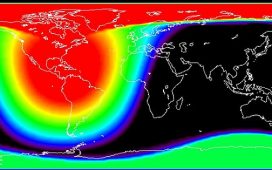A small asteroid exploded over the English channel, near Normandy, in the early hours of this morning. The light show from the shooting star’s “airburst” was visible across most of southern England and Wales — and even as far south as Paris, France. The incident was rare, experts said in that the asteroid disintegrated in sight of populated areas with advance warning, allowing significant data collection.
Designated “Sar2667” and then “2023 CX₁” by astronomers, the space rock is estimated to have been around 3.3 feet in size.
This is just above the lower limit for classification as an asteroid. Smaller rocky bodies are known as meteors.
2023 CX₁ entered the atmosphere at 3am this morning, travelling eastward over the English Channel with an angle of descent of between 40–50° relative to the vertical.
The sight of it burning up as a result of atmospheric drag was also reported as visible in parts of Belgium and the Netherlands.
Physicist Dr Mark Boslough of the Los Alamos National Laboratory in New Mexico is an expert on airbursts.
He told Wales Online: “Airbursts of this size happen somewhere [in Earth’s atmosphere] several times per year.
However, he noted, they are “rarely discovered in advance” and that this is the first time that one has occurred “over a populated area with enough warning to get data.”
In fact, 2023 CX₁ is only the seventh asteroid to date to have been detected before it entered the Earth’s atmosphere.
READ MORE: ‘Bubbling’ early universe may resolve long-standing physics mystery
2023 CX₁ was first discovered by the Hungarian astronomer Krisztián Sárneczky at 8.18pm GMT yesterday, when the body was less than 145,000 miles from Earth — well inside the orbit of the Moon — and travelling at a relative velocity of 10.8 miles per second.
It was he that gave the asteroid the temporary designation of Sar2667 and reported it to the Minor Planet Center, the International Astronomical Union’s official body for the observation of minor planets, which is based at the Smithsonian Astrophysical Observatory in Cambridge, Massachusetts.
Subsequently, at 9.03pm GMT, the Višnjan Observatory in Tičan, Croatia confirmed that the asteroid was on a collision course with the Earth.
Overall, more than 20 observatories were capable of observing and tracking the asteroid prior to its disintegration in the Earth’s atmosphere.
It was last observed by the Rantiga Osservatorio at Tincana, Italy just 13 minutes before impact, as the rock was at an altitude of roughly 2,200 miles above sea level.
DON’T MISS:
Photographer captures perfectly camouflaged bird hidden among pebbles [REPORT]
China’s police gets rodent recruits with drug sniffing squirrels [ANALYSIS]
Fusion milestone as UK firm builds ‘crucial’ part for limitless energy [INSIGHT]
Today’s lightshow comes just weeks after a meteor was caught streaking across the skies above Taffs Well, near Cardiff, on a man’s Ring doorbell camera.
In the footage — shared by one Colin Hyde — a white light can be seen getting increasingly brighter as it moves across the night sky.
The shooting star was also seen across much of England, including Essex, Hertfordshire, London, Sussex, West Midlands, Wiltshire and Wolverhampton.
According to the Met Office, clear skies on that evening contributed to the quality of observations of the meteor.











